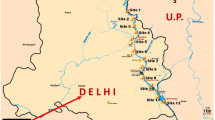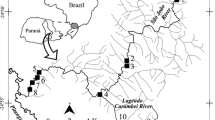Abstract
During the last two decades, the changes in the economic setting of the Basra province and the hydrological system of the Shatt Al-Arab River have led to significant shifts in the sources and levels of contaminants in the river. Therefore, the levels of toxic metals (Ni, Cr, Pb, As, Hg, U, and Cd) in the surface water and bed sediments at four sites have been measured to investigate the natural and anthropogenic influences that have led to these shifts. In comparison with the sediments, low concentrations and a uniform distribution of most metals were observed in the river water. The results show that the river sediments were polluted with toxic metals, while pollution levels in the water are still within permissible limits for drinking, irrigation, and aquatic life. These findings indicated that the major sources of river contamination with toxic metals are the atmospheric deposit of gaseous emissions from oil production and electric generators and the surface runoff from agricultural areas after rainfall. In addition, the tide greatly controls the distribution toxic metals in the river. In addition, the physicochemical properties of the water and sediments play an important role in the metal accumulation, while the effect of agricultural, industrial, and domestic sewage is limited. However, the water quality in the Shatt Al-Arab River reflects the combined effects of natural and anthropogenic factors.





Similar content being viewed by others
References
Abaychi JK, Douabul AA (1985) Trace metals in Shatt Al-Arab river, Iraq. Water Res 19(4):457–462
Abdullah EJ (2013) Quality assessment for Shatt Al-Arab River using heavy metal pollution index and metal index. J Environ Earth Sci 3(5):114–120. http://www.iiste.org
Abdullah AD (2016) Modelling approaches to understand salinity variations in a highly dynamic tidal river, the case of the Shatt al-Arab River, dissertation of Delft University of Technology and of the Academic Board of the UNESCO-IHE, p 186
Al-Asadi SA (2017) The future of freshwater in Shatt Al-Arab River (Southern Iraq). J Geogr Geol 9(2):24–38. https://doi.org/10.5539/jgg.v9n2p
Al-Asadi SA, Abdullah SS, Al-Mahmood HKh (2015) Estimation of minimum amount of the net discharge in the Shatt Al-Arab River (south of Iraq). J Adab Al-Basrah 2:285–314 (In Arabic)
Al-Hejuje MM, Hussain NA, Al-Saad HT (2017) Applied heavy metals pollution index (HPI) as a water pollution indicator of Shatt Al-Arab River, Basrah-Iraq. Int J Mar Sci 7(35):353–360. https://doi.org/10.5376/ijms.2017.07.0035
Al-Ibrahimi YA, Ghalib HB (2018) Hydrogeochemical modeling of groundwater at Al-Nile Area, Center of Babylon Governorate, Iraq. J Univ Babylon Pure Appl Sci 26(9):180–197
Al-Jaberi MH, Al-Dabbas MA, Al-Khafaji R (2016) Assessment of heavy metals of heavy metals contamination and sediment quality in Shatt Al-Arab River, Iraq. Iraqi Geol J 39–49(1):88–98
Al-Ramadhan B, Pastour M (1987) Tidal characteristics of Shatt Al-Arab River. Mesopotamian J Mar Sci 2(1):15–28
Al-Tawash B, Al-Lafta H, Merkel B (2013) Multivariate statistical evaluation of major and trace elements in Shatt Al-Arab sediments, Southern Iraq. J Environ Earth Sci 3(11):146–155. http://www.iiste.org
Al-Tememi MK, Hussein MA, Khaleefa UQ, Ghalib HB, AL-Mayah AM, Ruhmah AJ (2015) The salts diffusion between East Hammar marsh area and Shatt Al-Arab River Northern Basra City. Marsh Bull 10(1):36–45
APHA (1998) Standard methods for the examination of water and wastewater, 20th edn. American Public Health Association, Washington
Ayers RS, Westcot DW (1994) Water quality for agriculture. FAO irrigation and drainage paper, 29 Rev. 1, Italy
Bastami KD, Hossein B, Sarah H, Farzaneh S, Ali H, Mousa DB (2012) Geochemical and geo-statistical assessment of selected heavy metals in the surface sediments of the Gorgan Bay, Iran. Mar Pollut Bull 64(12):2877–2884
CCME (2001) Canadian Sediment Quality Guidelines for the protection of aquatic life: summary tables; Canadian environmental guidelines. Canadian Council of Ministers of the Environment, Winnipeg
Das S, Raj R, Mangwani N, Dash H, Chakraborty J (2014) Heavy metals and hydrocarbons: adverse effects and mechanism of toxicity, microbial biodegradation and bioremediation. Elsevier, New York, pp 23–54. https://doi.org/10.1016/B978-0-12-800021-2.00002-9
Edokpayi JN, Odiyo JO, Popoola OE, Msagati TA (2016) Assessment of trace metals contamination of surface water and sediment: a case study of Mvudi River, South Africa. Sustainability 8(135):1–13. http://www.mdpi.com/journal/Sustainability
Fowler SW, Huynh-Ngoc L, Fukai R (1984) Dissolved and particulate trace metals in coastal waters of the Gulf and Western Arabian Sea. Deep sea research part A. Oceanogr Res Papers 31(6–8):719–729
Gao X, Chen C-TA (2012) Heavy metal pollution status in surface sediments of the coastal Bohai Bay. Water Res 46:1901–1911
Ghalib HB (2017) Groundwater chemistry evaluation for drinking and irrigation utilities in east Wasit province, Central Iraq. Appl Water Sci 7(7):3447–3467. https://doi.org/10.1007/s13201-017-0575-8
Ghalib HB, Sogut AR (2014) Environmental isotopic characterization of groundwater and surface water in Northeast Missan Province. S Iraq ACGS Acta Geol Sin Eng Edn 88:1227–1238. https://doi.org/10.1111/1755-6724.12285
He ZL, Yang XE, Stoffella PJ (2005) Trace elements in agroecosystems and impacts on the environment. J Trace Elem Med Biol 19(2–3):125–140
Islam MS, Ahmed MK, Habibullah-Al-Mamun M, Hoque MF (2015) Preliminary assessment of heavy metal contamination in surface sediments from a river in Bangladesh. Environ Earth Sci 73(4):1837–1848
Kamunda C, Mathuthu M, Madhuku M (2016) Health risk assessment of heavy metals in soils from Witwatersrand Gold Mining Basin, South Africa. Int J Environ Res Public Health 13(663):1–11. https://doi.org/10.3390/ijerph13070663
Khan A, Ghouri A (2011) Environmental pollution: its effects on life and its remedies. J Arts Sci Commerce 2(2):276–285
Malik DS, Maurya PK (2015) Heavy metal concentration in water, sediment, and tissues of fish species (Heteropneustis fossilis and Puntius ticto) from Kali River, India. Toxicol Environ Chem 96(8):1195–1206. https://doi.org/10.1080/02772248.2015.1015296
Manavi PN (2013) Heavy metals in water, sediment and macrobenthos in the interdidal zone of Hormozgan Province, Iran. Mar Sci 3(2):39–47. https://doi.org/10.5923/j.ms.20130302.01
Mimba ME, Ohba T, Nguemhe Fils SC, Wirmvem MJ, Numanami N, Aka FT (2017) Seasonal hydrological inputs of major ions and trace metal composition in streams draining the mineralized Lom Basin, East Cameroon: basis for environmental studies. Earth Syst Environ 1(22):1–9. https://doi.org/10.1007/s41748-017-0026-6
Ministry of Agriculture (2017) Agricultural indicators, Basrah (Unpublished)
Ministry of Oil (2017) Basra Oil Company, Basrah (Unpublished)
Ministry of Planning (2017) Central statistical organization, demographic indicators, Republic of Iraq, Baghdad (Unpublished)
Moyel MS, Amteghy AH, Hassan WF, Mahdi EA, Khalaf HH (2015) Application and evaluation of water quality pollution indices for heavy metal contamination as a monitoring tool in Shatt Al Arab river. J Int Academic Res Multidiscip 3(4):67–75
Nand V, Maata M, Koshy K (2012) Water purification using Moringa oleifera and other locally available seeds in Fiji for heavy metal removal. Int J Appl Sci Technol 2(5):125–129
Pacyna JM, Pacyna EG (2001) An assessment of global and regional emissions of trace metals to the atmosphere from anthropogenic sources worldwide. Environ Rev 9(4):269–298. https://doi.org/10.1139/a01-012
Pendias AK, Pendias H (2001) Trace elements in soils and plants, 3rd edn. CRC Press, London, p 403
Schneider RF (1971) The impact of various heavy metals on the aquatic environment: technical report number 2. Environmental Protection Agency Water Quality Office, Denver Center, Colorado, p 25
Shanbehzadeh S, Dastjerdi MV, Hassanzadeh A, Kiyanizadeh T (2014) Heavy metals in water and sediment: a case study of Tembi River. J Environ Public Health 2014:1–5. https://doi.org/10.1155/2014/858720
Singh R, Gautam N, Mishra A, Gupta R (2011) Heavy metals and living systems: an overview. Indian J Pharmacol 43(3):246–253. https://doi.org/10.4103/0253-7613.81505
Tchounwou PB, Yedjou CG, Patlolla AK, Sutton DJ (2012) Heavy metals toxicity and the environment. Mol Clin Environ Toxicol Springer 3:133–164
United Nations Economic and Social Commission for Western Asia (ESCWA) (2013) Inventory of shared water resources in western Asia, New York, vol 2014. https://doi.org/10.1155/2014/858720
World Health Organization (WHO) (2006) Guidelines for drinking-water quality, first addendum to third edition, vol 1
Acknowledgements
We would like to thank Prof. Dr. Hamdan B. Nomas, Department of Geography, College of Education, University of Basrah, for valuable and very interesting. Many thanks also for Prof. Dr. Jinan F. B. Al-Hajaj, Department of English, College of Education, University of Basrah for reviewing the language of this manuscript.
Author information
Authors and Affiliations
Corresponding author
Rights and permissions
About this article
Cite this article
Al-Asadi, S.A.R., Al Hawash, A.B., Alkhlifa, NH.A.H. et al. Factors Affecting the Levels of Toxic Metals in the Shatt Al-Arab River, Southern Iraq. Earth Syst Environ 3, 313–325 (2019). https://doi.org/10.1007/s41748-019-00096-y
Received:
Accepted:
Published:
Issue Date:
DOI: https://doi.org/10.1007/s41748-019-00096-y




